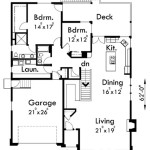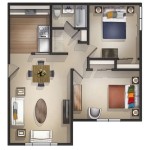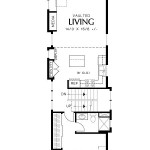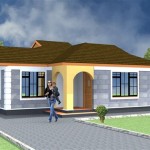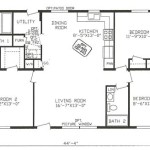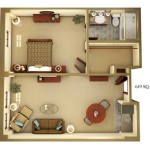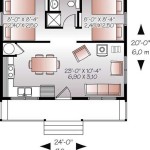House Plans with Wrap Around Porch and Walkout Basement: Maximizing Space and Lifestyle
The integration of a wrap-around porch and a walkout basement into a house plan offers a compelling combination of architectural aesthetics and functional living space. These features not only enhance the visual appeal of a home but also contribute significantly to its livability and potential for expansion or diverse usage. House plans incorporating these elements are particularly well-suited for properties with varied topography, allowing for seamless integration with the natural landscape and maximizing the value of outdoor living.
A wrap-around porch, extending along multiple sides of the house, provides ample space for relaxation, entertainment, and enjoying the surrounding views. Its design encourages a connection with the outdoors, offering shaded areas for respite from the sun and covered protection from inclement weather. The walkout basement, accessible directly from the lower level to the outdoors, transforms what might otherwise be a dark and underutilized space into a bright, functional area suitable for a variety of purposes, from recreational spaces to guest suites or even home offices.
Enhancing Outdoor Living and Curb Appeal
The wrap-around porch is a defining feature that significantly enhances the outdoor living experience and contributes to the overall curb appeal of a home. Its expansive design provides a generous outdoor space that can be customized to suit individual needs and preferences. Homeowners often utilize wrap-around porches for outdoor dining, lounging, and entertaining guests. The porch can be furnished with comfortable seating, outdoor lighting, and even outdoor kitchens, creating an extension of the indoor living space.
From an aesthetic perspective, the wrap-around porch lends a classic and inviting charm to a house. It often evokes a sense of Southern hospitality and timeless elegance. The architectural style can be adapted to various home designs, from traditional farmhouses to contemporary craftsman styles. The porch can be constructed using a variety of materials, such as wood, composite decking, or concrete, and can be further enhanced with decorative railings, columns, and trim. The careful selection of materials and design elements can create a porch that is both aesthetically pleasing and durable, requiring minimal maintenance over time.
Furthermore, the wrap-around porch provides practical benefits, such as shading the house from direct sunlight, reducing energy consumption during warmer months. It also offers protection from rain and snow, allowing homeowners to enjoy the outdoors even in inclement weather. The porch can also serve as a buffer zone, protecting the interior of the house from the elements and reducing wear and tear on exterior walls and windows.
Maximizing Space and Functionality with a Walkout Basement
The walkout basement is a valuable asset that significantly expands the usable living space of a home. Unlike traditional basements, which are often partially or fully submerged underground, a walkout basement has at least one side that is fully exposed to the outdoors. This allows for the installation of windows and doors, providing natural light and direct access to the yard. The design of a walkout basement is particularly advantageous for properties with sloping terrains, where the natural grade provides the necessary elevation for the walkout access.
The functionality of a walkout basement is highly versatile. It can be finished and transformed into a variety of living spaces, such as recreational rooms, home theaters, guest suites, home offices, or even rental apartments. The direct access to the outdoors makes it an ideal location for a children's playroom, a home gym, or a workshop. The walkout basement can also be designed with a separate entrance, providing privacy and independence for guests or tenants. The possibilities are limited only by the homeowner's imagination and budget.
From a structural perspective, the walkout basement can provide additional stability and support to the house. The foundation walls of the basement act as retaining walls, preventing soil erosion and landslides. The basement also provides a buffer zone that helps to regulate the temperature of the house, keeping it cooler in the summer and warmer in the winter. This can significantly reduce energy costs and improve the overall comfort of the home.
When planning a house with a walkout basement, it is essential to consider factors such as drainage, waterproofing, and insulation. Proper drainage is crucial to prevent water damage and mold growth. Waterproofing the foundation walls is essential to protect the interior of the basement from moisture. Insulation helps to regulate the temperature and reduce energy costs. Careful planning and attention to detail will ensure that the walkout basement is a valuable and functional addition to the home.
Integrating Wrap Around Porch and Walkout Basement in House Plans
The successful integration of a wrap-around porch and a walkout basement in a house plan requires careful consideration of the site's topography, the desired architectural style, and the functional needs of the homeowner. The design must seamlessly blend these two features into a cohesive and harmonious whole. The placement of the porch and the walkout basement should complement each other, enhancing the overall appeal and functionality of the house.
When integrating these features, consider the orientation of the house and the prevailing winds. The wrap-around porch can be designed to provide shade during the hottest part of the day, while the walkout basement can be positioned to take advantage of natural light and ventilation. The porch and the basement can also be connected by stairs, creating a seamless transition between the upper and lower levels of the house. This connection can be further enhanced by landscaping, creating a natural flow between the indoor and outdoor spaces.
The architectural style of the house should also be considered when integrating the wrap-around porch and the walkout basement. The porch can be designed to complement the overall style of the house, whether it is a traditional farmhouse, a contemporary craftsman, or a modern design. The basement can be finished to match the interior of the house, creating a seamless transition between the upper and lower levels. The choice of materials, colors, and finishes should be consistent throughout the house, creating a cohesive and harmonious design.
Finally, the functional needs of the homeowner should be carefully considered when integrating the wrap-around porch and the walkout basement. The porch should be designed to accommodate the desired outdoor activities, such as dining, lounging, and entertaining. The basement should be finished to meet the specific needs of the homeowner, whether it is a recreational room, a home theater, a guest suite, or a home office. The design should be flexible and adaptable, allowing the homeowner to customize the space to suit their changing needs over time.
In summary, house plans with wrap-around porches and walkout basements offer a unique and compelling combination of architectural aesthetics and functional living space. These features enhance the outdoor living experience, expand the usable living space of the home, and provide a seamless connection with the natural landscape. Careful planning and attention to detail are essential to ensure that these features are successfully integrated into the house plan, creating a comfortable, functional, and aesthetically pleasing home.
The design choices surrounding the wrap-around porch can significantly impact the overall aesthetic of the home. The size and shape of the porch, the materials used for its construction, and the details of its railings and columns all contribute to its visual appeal. A wide, expansive porch can create a grand and welcoming entrance, while a narrower porch may offer a more intimate and cozy feel. The materials used for the porch can also influence its style, with wood providing a classic and traditional look, while composite decking offers a more modern and low-maintenance option.
Similarly, the design of the walkout basement can have a significant impact on its functionality and appeal. The placement of windows and doors, the layout of the interior spaces, and the materials used for finishing all contribute to its usability and comfort. Large windows and doors can bring in natural light and provide direct access to the outdoors, while a well-designed layout can maximize the use of space and create a comfortable living environment. The materials used for finishing the basement can also influence its style, with drywall and paint providing a clean and modern look, while wood paneling and stone accents can create a more rustic and cozy feel.
Ultimately, the successful integration of a wrap-around porch and a walkout basement into a house plan depends on careful planning, attention to detail, and a clear understanding of the homeowner's needs and preferences. By considering these factors, it is possible to create a home that is both aesthetically pleasing and highly functional, providing a comfortable and enjoyable living environment for years to come.

4 Or 5 Bedroom Home Plan With Wraparound Porch And Walkout Basement 77641fb Architectural Designs House Plans

3 Bedroom Open Floor Plan With Wraparound Porch And Basement Craftsman House Plans Ranch Style

3 Bedroom Open Floor Plan With Wraparound Porch And Basement

3 Bedroom Open Floor Plan With Wraparound Porch And Basement Lakefront House Plans

4 Or 5 Bedroom Home Plan With Wraparound Porch And Walkout Basement 77641fb Architectural Designs House Plans

Open Floor Plan With Wrap Around Porch Banner Elk Ii

3 Bedroom Open Floor Plan With Wraparound Porch And Basement Lake House Plans Lakefront Homes

House Plan 3 Bedrooms 1 Bathrooms 3900a Drummond Plans

Plan 85208 Mountainside House With Walk Out Basement

3 Bedroom Open Floor Plan With Wraparound Porch And Basement Lakefront House Plans Exterior

